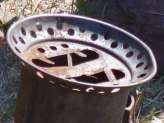Fruit Wood Tool Handles
Tough and Strong Fine Grained Wood for Artisans Tools
My Dad, my Granddad and my great Granddad were all carpenters and carvers.
Andrew Lisle, my great Granddad was an organ builder in York, but traveled to many far off lands with tools packed carefully in a huge five plank chest to build and carve cathedrals and churches.
William Herbert Cammidge, my Granddad, was apprenticed to Andrew Lisle, and that’s how he met (and eventually married) Annie Elizabeth Lisle, my Grandmother.
The line doesn’t end there – as a twig artisan, I think I’ve got the wood carving gene too.
My carving and woodwork may be a little more rustic than my forebears, but the old pictures show a surprising detail; many of these old photographs show a group of my family members posing in front of twig pergolas and trellises. How interesting is that?
One of the items that I’ve been fortunate to inherit is a collection of my Great Granddads chisels, which also contain in their midst a few of my Dads – all made with fruit wood handles.

Fruit wood such as apple or pear wood is fine grained, and almost indestructible, making it the perfect material to carve into tool handles.
The handles in this collection are obviously built over a long period, as some have my Great Granddads name stamped into them, others my Dads name.
The way they were carved is a mystery, but it’s obvious that some type of lathe was used. I’m imagining that it was probably turned by a foot pedal, not a motor, but unfortunately, this part of our family history is lost.
 My collection of chisels and the tool chest they traveled in
My collection of chisels and the tool chest they traveled inAt a rough estimate, the earliest of these fruit wood tool handles would have been crafted in the early part of the 1900’s, the last ones around 1940 or so.
This gives particular meaning to the collection, as they are well over 100 years old.
They are turned on a lathe, polished, and stamped with the craftsmans name. I have never come across the stamps in the collection of old tools, and I'm curious where those would have come from. Time to research that.
Some in this collection look older, and have no stamped name imprinted, so I’m imagining an even earlier generation of carvers using these craftsmen’s tools, never dreaming that four or five generations later, they would be a source of wonder and appreciation for their art.
Find out more about my family's history of woodworking here.
Learn what it takes to be creative - we all have the gene but how do we develop it? Get the free guide!
Fill in the form below for your copy;
(Don't be disappointed - use an email address that will accept the free download - some .aol email addresses won't.
If you don't see your download within a few minutes, try again with another email address - sorry for the bother.)


















